In 1911 the Greek Government appointed French specialists to form the Hellenic Aviation Service. Six Greek officers were sent to France for training, while the first four "Farman" type aircraft were ordered. The first Greek aviator was Emmanuel Argyropoulos, who flew in a Nieuport IV.G. "Alcuin" aircraft, on February 8, 1912.
The first military flight was made on 13 May of that year by Lieutenant Dimitrios Kamberos. In June, Kamberos, flew with the "Daedalus", a Farman Aviation Works aircraft that had been converted into a seaplane, setting the foundations of Naval Aviation. That September, the Greek Army fielded its first squadron, the Aviators Company(Λόχος Αεροπόρων).

The Hellenic Air Force participated in the Balkan Wars, World War I, the Asia Minor Campaign and World War II.
Initially it consisted of the separate Army Aviation and Naval Aviation, but in 1930 the Aviation Ministry was founded, establishing the Air Force as the third branch of the Hellenic Armed Forces. In 1931 the Air Force Academy, the "Icarus School of Basic and Advanced Fighter Training" (Sholi Icaron), was founded.
During the Second World War, it successfully resisted the Italian invasion in 1940, but practically the entire force was destroyed by the Germans in April 1941. The Air Force was rebuilt in the Middle East as part of the Royal Air Force, flying Spitfires , Hurricanes and Martin Baltimores .
After Greece's liberation in 1944, it returned home and subsequently participated in the Greek Civil War.
In the 1950s, the force was rebuilt and organized according to NATO standards. The Greek Air Force participated in the Korean War with a transport flight unit.
Until the late 1980s the Air Force deployed Nike-Hercules Missiles armed with U.S. nuclear warheads. As a result of Greco-Turkish tensions around the 1974 Turkish invasion of Cyprus, the U.S. removed its nuclear weapons from Greek and Turkish alert units to storage. Greece saw this as another pro-Turkish move by NATO and withdrew its forces from NATO's military command structure from 1974 to 1980.
In 1988 the first 3rd generation fighters were introduced, marking the beginning of a new era: The first Mirage 2000 EG/BG aircraft were delivered to the 114th Combat Wing and equipped the 331 and 332 squadrons.
In January 1989, the first F-16C/D Block 30 arrived in Nea Anchialos (111th Combat Wing) and were allocated between the 330 and 346 squadrons.

On March 29, 1991, the RF-84F were retired from service after 34 years and 7 months of operational life. In November 1992 more RF-4E were delivered to the 348 Tactical Reconnaissance Squadron.
In 1997 the reception of third generation aircraft continued. In July, delivery of forty F-16 Block 50 begun. The new aircraft, equipped with the LANTIRN navigation and targeting pod as well as AMRAAM and HARM missiles, were allocated to the 341 and 347 squadrons.

Greece participated in NATO "nuclear weapons sharing" until 2001, using A-7 Corsair IIs to deploy tactical B61 nuclear warheads from Araxos Air Base. Greece then strategically decided to remove all nuclear weapons under storage in Greece and did not purchase any more aircraft with nuclear capabilities.
In 2005, Greece was among the first countries to add the F-16 Block 52+ to its inventory. Ninety of these aircraft were ordered and delivery began the same year. This advanced F-16 type is an improved version of the Block 50 featuring a more powerful radar, better communications systems and an upgraded engine. The Hellenic Air Force's Block 52+ belong to the 337, 340 and 343 Squadrons with call signs "Ghost", "Fox" and "Star" respectively. 337 SQ is based at Larissa Air Force Base (110 Combat Wing) and the other two in Souda AB (115 CW).
In 2007, the Hellenic Air Force has a total fighter fleet of 275 modern, upgraded or under upgrade aircraft and due to the retirement of some fighter planes that have ended their life-cycle, HAF is looking forward to acquiring new 3rd and 4th generation fighters in order to reach a total number of 300 modern fighters, according to the "2007 Supreme Air Force Council Memorandum" published in 2007. This goal is to be gradually reached by 2015. Prime candidates for a 4th generation aircraft, of which acquisition is considered certain, are the Eurofighter Typhoon, F-35 Lightning II (JSF) and Dassault Rafale.

The Northrop F-5 is a family of supersonic light fighter aircraft initially designed as a privately funded project in the late 1950s by Northrop Corporation. There are two main models, the original F-5A and F-5B Freedom Fighter variants and the extensively updated F-5E and F-5F Tiger II variants. The design team wrapped a small, highly aerodynamic fighter around two compact and high-thrust General Electric J85 engines, focusing on performance and a low cost of maintenance. Smaller and simpler than contemporaries such as the McDonnell Douglas F-4 Phantom II, the F-5 cost less to procure and operate, making it a popular export aircraft. Though primarily designed for a day air superiority role, the aircraft is also a capable ground-attack platform. The F-5A entered service in the early 1960s. During the Cold War, over 800 were produced through 1972 for US allies. Though at the time the United States Air Force (USAF) did not have a need for a light fighter, it did procure approximately 1,200 Northrop T-38 Talon trainer aircraft, which was based on Northrop's N-156 fighter design.

The General Dynamics F-16 Fighting Falcon is an American single-engine supersonic multirole fighter aircraft originally developed by General Dynamics for the United States Air Force (USAF). Designed as an air superiority day fighter, it evolved into a successful all-weather multirole aircraft with over 4,600 built since 1976. Although no longer purchased by the U.S. Air Force, improved versions are being built for export. In 1993, General Dynamics sold its aircraft manufacturing business to the Lockheed Corporation, which became part of Lockheed Martin after a 1995 merger with Martin Marietta.
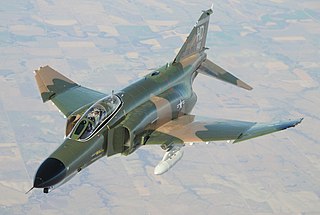
The McDonnell Douglas F-4 Phantom II is an American tandem two-seat, twin-engine, all-weather, long-range supersonic jet interceptor and fighter-bomber originally developed by McDonnell Aircraft for the United States Navy. Proving highly adaptable, it entered service with the Navy in 1961 before it was adopted by the United States Marine Corps and the United States Air Force, and by the mid-1960s it had become a major part of their air arms. Phantom production ran from 1958 to 1981 with a total of 5,195 aircraft built, making it the most produced American supersonic military aircraft in history, and cementing its position as a signature combat aircraft of the Cold War.

The Hellenic Air Force is the air force of Greece. It is considered to be one of the largest air forces in NATO, and is globally placed 18th out of 139 countries. Under the Kingdom of Greece from 1935 to 1973, it was previously known as the Royal Hellenic Air Force (RHAF).

The Royal Netherlands Air Force is the military aviation branch of the Netherlands Armed Forces. It was created in 1953 to succeed its predecessor, the Luchtvaartafdeling of the Dutch Army, which was founded in 1913. The aerobatic display team of the Royal Netherlands Air Force, active from 1979 until 2019, was the Solo Display Team.

The German Air Force is the aerial warfare branch of the Bundeswehr, the armed forces of Germany. The German Air Force was founded in 1956 during the era of the Cold War as the aerial warfare branch of the armed forces of West Germany. After the reunification of West and East Germany in 1990, it integrated parts of the air force of the former German Democratic Republic, which itself had been founded in 1956 as part of the National People's Army. There is no organizational continuity between the current German Air Force and the former Luftwaffe of the Wehrmacht founded in 1935, which was completely disbanded in 1945/46 after World War II. The term Luftwaffe that is used for both the historic and the current German air force is the German-language generic designation of any air force.
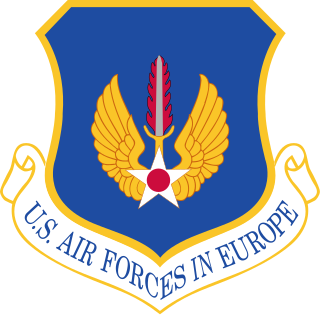
The United States Air Forces in Europe – Air Forces Africa (USAFE-AFAFRICA) is a United States Air Force (USAF) major command (MAJCOM) and a component command of both United States European Command (USEUCOM) and United States Africa Command (USAFRICOM). As part of its mission, USAFE-AFAFRICA commands U.S. Air Force units pledged to NATO, maintaining combat-ready wings based from the United Kingdom to Turkey. USAFE-AFAFRICA plans, conducts, controls, coordinates and supports air and space operations in Europe, parts of Asia and all of Africa with the exception of Egypt to achieve U.S. national and NATO objectives based on taskings by the two combatant commanders.

Aviano Air Base is a base in northeastern Italy, in the Friuli Venezia Giulia region. It is located in the Aviano municipality, at the foot of the Carnic Pre-Alps or Southern Carnic Alps, about 15 kilometres (9.3 mi) from Pordenone.
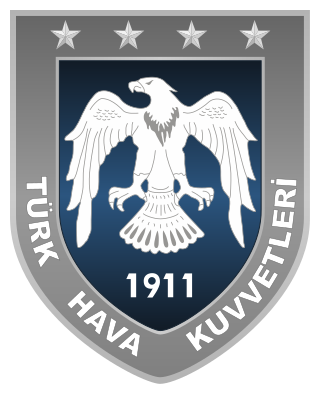
The Turkish Air Force is the aerial warfare service branch of the Turkish Armed Forces. It traces its origins to June 1911 when it was founded as the Aviation Squadrons by the Ottoman Empire. It was composed of the Army Aviation Squadrons founded in 1911, and the Naval Aviation Squadrons founded in 1914 which used seaplanes. The Air Force as a branch of the Turkish Armed Forces was founded by the Grand National Assembly of Turkey on 23 April 1920.
The Hellenic Aviation was first established in 1911 with help from French experts. The air force of Greece or the Hellenic Air Force participated in the Balkan Wars, World War I, the Asia Minor War, World War II, the Greek Civil War, the Korean War and the Turkish invasion of Cyprus.
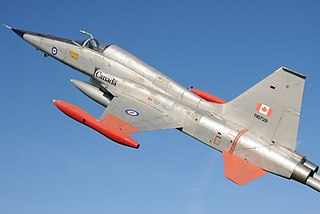
The Canadair CF-5 is a Canadian licensed-built Northrop F-5 Freedom Fighter. It is a light, supersonic, twin engine, daylight air superiority fighter primarily for the Canadian Forces and the Royal Netherlands Air Force. The CF-5 was upgraded periodically throughout its service life in Canada. While Canadian Forces retired the aircraft in 1995, it continues to be used by other countries.

The 178th Wing is a unit of the Ohio Air National Guard, stationed at the Springfield-Beckley Municipal Airport ANG complex, Springfield, Ohio. If activated to federal service, the wing is gained by the United States Air Force Air Combat Command (ACC), with elements of the wing gained by the Air Force Intelligence, Surveillance and Reconnaissance Agency (AFISRA).

F-4 Phantom II non-U.S. operators are the non-U.S. nations with air forces that operate or used to operate the McDonnell Douglas F-4 Phantom II. The Phantom II entered service with the U.S. military in 1960 and served until 1996. During this time it was the primary interceptor, air superiority fighter and fighter bomber with the U.S. Navy, Marines and Air Force.
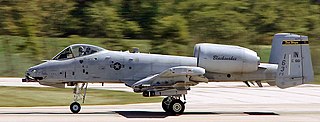
The 163rd Fighter Squadron is a unit of the Indiana Air National Guard's 122nd Fighter Wing, located at Fort Wayne Air National Guard Station, Indiana. The 163rd is currently transitioning from the A-10 Thunderbolt II to the F-16 Fighting Falcon.

The 162nd Attack Squadron is a unit of the Ohio Air National Guard 178th Wing located at Springfield Air National Guard Base, Springfield, Ohio. The 162nd is equipped with the General Atomics MQ-9 Reaper UAV.

The 113th Air Support Operations Squadron is a unit of the Indiana Air National Guard 181st Intelligence Wing located at Terre Haute Air National Guard Base, Indiana.

The 493rd Fighter Squadron, nicknamed the Grim Reapers, is part of the United States Air Force's 48th Fighter Wing located at RAF Lakenheath, Suffolk, United Kingdom. The 493rd FS operates the Lockheed Martin F-35A Lightning II. The squadron has earned multiple commendations and awards, including the Air Force Association's Hughes Trophy in 1997 and 1999 and the 2007, 2014, 2016 and 2019 Raytheon Trophies, for being recognized as the top fighter squadron in the United States Air Force.
The 335th Squadron, callsign "Tigers", is the oldest squadron in service with the Hellenic Air Force formed on the 10th of October 1941 at Aqir airfield in Palestine as a unit in exile. It is based at Araxos Air Base in the Peloponnese, forming part of the 116th Combat Wing. Until March 2008, the squadron was equipped with the A-7H Corsair, and is operating with 30 newly purchased F-16 Block 52+ aircraft.
The 336th Bomber Squadron, callsign "Olympus", is the second oldest squadron in service with the Hellenic Air Force, forming part of the 116th Combat Wing. It is based at Araxos Air Base in the Peloponnese, and operates the F-16 Block 52 Advanced aircraft.
The Naval Air Service was the air arm of the Hellenic Navy from 1915 to 1930.